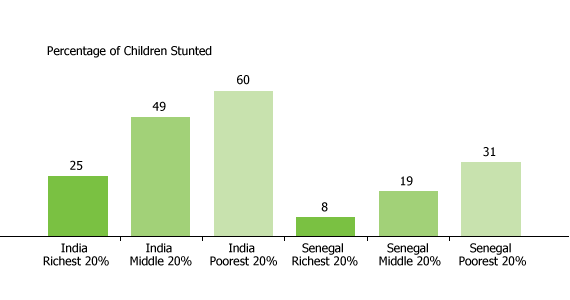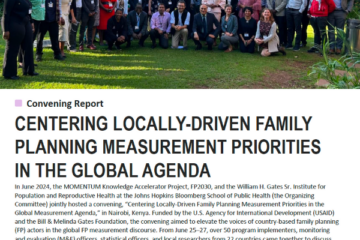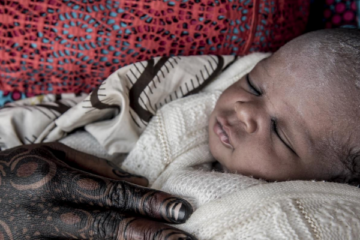
Combating Malnutrition With More Than Income Growth
(August 2012) Worldwide, malnutrition contributes to 2.6 million child deaths each year, or more than one in three of all child deaths.1 While children living in poorer countries are more likely to be malnourished than children in wealthier countries, the proportion of children who are malnourished is not always associated with a country’s economic status. Some countries that have become economic powerhouses have persistently high numbers of malnourished children, while other countries with low levels of national income have shown progress in combating malnutrition by investing in cost-effective, proven interventions that ensure children’s access to proper nutrition. With political will, government and partner support, and the right strategies, more children across all countries can survive and reach their full potential.
The Income Factor
Income and economic growth can influence nutrition in many ways. Wealthier populations have the ability to purchase more diverse foods, including animal products rich in protein—the building blocks of healthy bodies—as well as fruits and vegetables rich in essential vitamins, minerals and other nutrients. Poorer populations often lack access to the right variety of foods and the right amount of foods, leading to inadequate nutrition. For the poorer populations, economic growth can boost household incomes, resulting in more spending on food, health, and education, and better individual health and nutrition. In addition, when national economies are growing, governments have more to spend on social programs and infrastructure necessary for health systems to function, thus increasing the overall health and nutritional status of the nation.2
The Malnutrition Paradox
Despite the effect of economic growth on malnutrition, national income levels are not the only factors contributing to malnutrition. Some countries have lower levels of stunting, or chronic malnourishment, than their gross national income (GNI) would suggest, while others are experiencing dramatically high levels of stunting for their income level. For example:
- While India has become one of the world’s largest economic markets, with a GNI of $3,620 per capita, almost half of its children are stunted. Even with India’s substantial growth in the past few decades—up from a GNI per capita of $980 in 1993—stunting levels have decreased by less than 10 percent. Remarkably, although most countries in sub-Saharan Africa have lower per-capita income than India, the majority of these countries have lower levels of child malnutrition.3
- In contrast to India, Senegal is making considerable progress in reducing malnutrition. The number of stunted children in Senegal has decreased dramatically over the last 20 years, dropping from one-third of children under 5 in 1993 to about one-sixth of children today. These stunting levels are much lower than neighboring countries with similar income levels in West Africa such as Mali or Guinea, both with 39 percent of children stunted.4
Malnutrition Not Unique to the Poor
While stark differences exist between India and Senegal, malnutrition in both countries is not just a problem affecting the poor (see figure). Even though stunting is 2.5 times more common among children in India’s poorest households than in the wealthiest ones, more than one-quarter of children in the richest families are stunted. A small percentage of children in Senegal’s richest families are stunted as well, but low national levels mask the differences by wealth: One-third of children are stunted in the poorest households in Senegal—the same as the national level 20 years ago.
Figure
Stunting Levels Differ By Wealth, But Stunting Still Affects Richest Families

Sources: International Institute for Population Sciences (IIPS) and Macro International, National Family Health Survey (NFHS-3) for India, 2005-2006 (Mumbai: IIPS, 2007); Salif Ndiaye and Mohamed Ayad, Demographic and Health Survey for Senegal, 2005 (Calverton, MD: Centre de Recherche pour le Développement Humain [Senegal] and Macro International, 2006); and World Bank, “International Comparison Program Database: GNI Per Capita” (2012), accessed on Aug. 20, 2012.
What Have We Learned?
Although there is no single solution to improving children’s nutrition, support for proven interventions can go a long way in decreasing malnutrition around the world. India’s Integrated Child Development Scheme is one of the largest national nutrition projects worldwide, yet more efforts are needed to expand and implement this program to reach those children most at risk.5 While the program provides supplemental nutrition for children already malnourished, more emphasis should be placed on increasing education on nutrition for parents and caregivers and increasing infrastructure needed to get the right amounts and variety of foods to children. Meanwhile, Senegal’s government, with support from international partners, implemented the Nutrition Enhancement Program in 1993. This program employs village health workers to promote and provide integrated community health interventions for children and has expanded to reach over half of all children most at risk of malnutrition, especially in the poorest villages.6
Interventions to Combat Malnutrition
We have the tools to decrease the number of malnourished children in all countries, regardless of their national income levels. Research has pointed to specific, cost-effective interventions that can decrease the number of children with malnutrition substantially.7 Investments in nutrition pay for themselves and can produce a lifetime of benefits for individuals, families, and nations. Key nutrition interventions include ensuring that:
- Mothers and children have access to—and are consuming—essential vitamins and minerals.
- Mothers and children have access to the right variety of foods and the right amount of foods.
- Parents and caregivers have access to the information and support they need to feed their children in the best way possible.8
These proven interventions can save the lives of thousands of children worldwide and help children reach their full potential: by contributing to better school performance, higher lifetime earnings, and increased productivity in the labor force. Senegal’s progress in combating malnutrition illustrates that political will, government and partner support, and commitment to proven interventions can decrease the number of children suffering from malnutrition, regardless of economic status. Now is the time for more countries—resource-rich and resource-poor countries alike—to build on these successes and prevent the devastating effects of child malnutrition.
Jill Hagey is a policy analyst in International Programs at the Population Reference Bureau.
References
- Save the Children, “Nutrition in the First 1,000 Days: State of the World’s Mothers 2012” (May 2012), accessed Aug. 20, 2012.
- Derek Headey, International Food Policy Research Institute (IFPRI), “Turning Economic Growth into Nutrition-Sensitive Growth,” 2020 Conference: Leveraging Agriculture for Improving Nutrition and Health (February 2011), accessed on Aug. 20, 2012.
- Sam Mendelson and Samir Chaudhuri, “Child Malnutrition in India: Why Does It Persist?” accessed on Aug. 20, 2012.
- International Development Association, “Senegal: Promoting Nutrition During Pregnancy and Early Childhood” (2012), accessed on Aug. 20, 2012 ; Cellule de Planification et de Statistique du Ministère de la Santé (CPS/MS), Direction Nationale de la Statistique et de l’Informatique du Ministère de l’Économie, de l’Industrie et du Commerce (DNSI/MEIC) and Macro International, Demographic and Health Survey for Mali, 2006 (Calverton, MD: CPS/DNSI and Macro International, 2006); and Direction Nationale de la Statistique (DNS Guinée) and Macro International, Demographic and Health Survey for Guinea, 2005 (Calverton, MD: DNS and Macro International, 2006).
- IFPRI et al., “Accelerating Progress Toward Reducing Child Malnutrition in India” (January 2008), accessed on Aug. 20, 2012.
- International Development Association, “Senegal.”
- Zulfigar A. Bhutta et al., “What Works? Interventions for Maternal and Child Undernutrition and Survival,” The Lancet 371, no. 9610 (2008): 417-40; and World Bank, Scaling Up Nutrition: What Will It Cost? (Washington, DC: World Bank, 2010).
- Ogilvy Public Relations Worldwide and the Academy for Educational Development (AED), A Communications Strategy to Mobilize Nutrition Investment (Washington, DC: World Bank, 2009).






